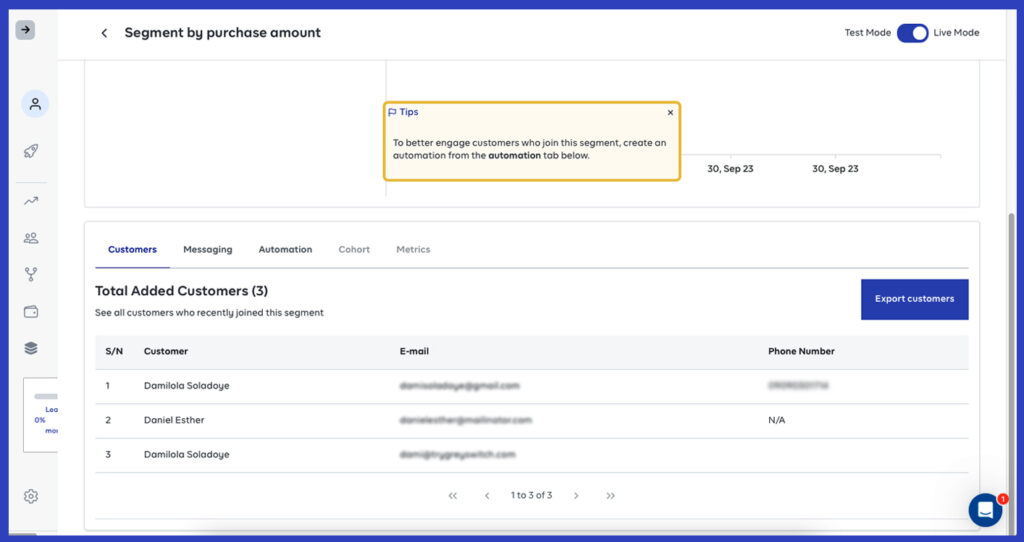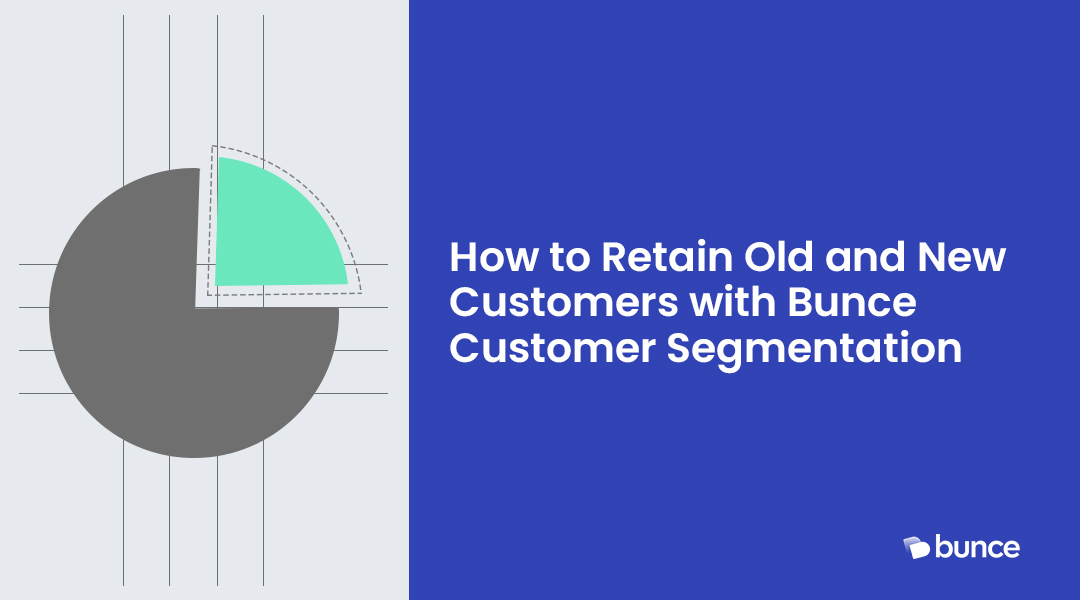It’s challenging to know the individual needs of your entire customer base but some attributes can help you group customers into segments so you send helpful messages, and relevant offers to retain your valuable customers.
Offering relevant recommendations and personal experiences to customers is vital because customers desire it. 91% of consumers say they will more likely shop from brands that recognise, remember and provide relevant recommendations to them. This proves generic messages no longer appeal to customers’ emotions. You need to send the right message to the right customer at the right time.
The goal is to retain your old and new customers and boost sales and customer loyalty, all of which segmentation can help you achieve.
You can uncover more revenue opportunities for your business if you properly segment customers and make your customer experience smoother.
On the other hand, friction in customer experience wastes money, and effort invested to acquire new customers. New customers show that your business is expanding, and old customers prove your business strategy is healthy. Your business needs both to thrive.
This is why it’s important to look into your customer payment data. This helps to understand their different needs so you can segment them and provide them with relevant and personalised recommendations that, in the end, increase customer retention, loyalty, and customer lifetime value.
If you are a marketing lead at an e-commerce business, or you are part of a marketing team, I wrote this for you. You’ll learn how Bunce’s customer segmentation reveals revenue and growth opportunities within your business, helping you make repeat purchases, and retain old and new customers.
Let’s dive in.
What is Customer Segmentation?
Customer segmentation is the grouping of customers based on unique characteristics like behaviour, demographics, and geographical data, and payment preferences.
For example, you can segment customers based on behaviours like what they buy, the method of payment they use, and if they abandon their carts so you can reach out to nudge them to make the purchase. You can also segment using demographic data like age, gender, and segment by geographical data like location.
Why is Customer Segmentation Important?
In a chat with Paul Ayuk, CEO of Bunce, on why businesses need to segment customers, he shared:
There’s already so much variation in customers’ behaviours__all your customers are not in the same customer journey or level and require different messages at different points of their journey to convert. if they only receive generic messages from you, you’d have a low conversion and retention rate. What you need to do is segment them so you can properly target them based on their customer journey and send personalised messages that can nudge them to come back. This ensures the messages you send out are relevant__ the business saves cost; money and time.
Paul’s thoughts sum up the importance of segmentation, your customer base isn’t just a list of contacts but of people with different characteristics and varying needs. Using generic messages for all is a waste of resources.
Segmentation shouldn’t be an afterthought, it should be part of your marketing outreach workflow. Donald Norman, Author and Co-founder Nielson Norman Group shared why. In his words:
“Marketing segmentation is a natural result of the vast differences amongst people.”
Here are some impacts customer segmentation can have on your business:
1. Saves Business Cost
Every department in an organization runs on money to be efficient, the marketing budget is paid for, the communication tools are paid for, and every event costs money. You need to invest in doing the right things to see results.
In Paul Ayuk’s words, on the subject of effective customer segmentation and channeling resources appropriately, “Email isn’t free, SMS isn’t free”. It is important to segment customers according to their unique criteria and send the right messages that are relevant and likely to convert them.
2. Deliver better customer experiences
When you segment your customer base into unique groups, you can make their experiences better by targeting them with the right content at the right time. This ensures you cut out generic messages that are not relatable and reduces the cycle it would take to close a sale if left to the customer to take the purchase initiative themselves.
When engaging customers, know when to avoid the ‘one for all method’. An example of this is a recent experience with an E-commerce store I once shopped with.
I got an email with the subject ‘grooming kits’. It piqued my interest but on opening, it was grooming kits for males, not females. I hadn’t browsed through male products in their store. Clearly, this could be a one for all sale.
And, my experience was abruptly cut short as it didn’t take me minutes to close the email since it was irrelevant to me. This goes to prove it’s one thing to get your audience’s interest, it’s another to sustain it.
But with customer segmentation, rest assured you’d nail both. Why? Segmenting your customers helps you get specific and deliver customized recommendations and experiences to your audience.
3. Reduce churn
Customers churn for reasons like poor customer support, lack of value, ineffective marketing, and better offers from competitors amongst others. Churn may be inevitable but when you do marketing right, it reduces churn. And that’s what proper segmentation and customer targeting help you achieve.
4. Discover Revenue Opportunities
As earlier agreed in our introduction, customer segmentation can uncover more revenue opportunities.
Case in point? When you sort through your customer base and segment them, you will discover money pointers, opportunities to upsell and cross sell to specific customer segments.
For example, on Bunce, you can segment customers who have bought from you consistently in the last 3 months and give them a discount on a more expensive product, that is relevant to them or consistent with the kind of items they’ve purchased.
5. Discover challenges and get Customer Feedback:
Good customer segmentation and engagement can reveal pain points and generate customer feedback. Discovering customer pain points gives you the opportunity to offer help to them and build stronger connections with your customers. And, putting customer feedback into action shows them that you care about their opinion and that they matter to your business.
In addition, positive feedback can serve as social proof for your business. This builds brand trust which is important to attract new customers.
How to Retain Old and New Customers Using Bunce’s Customer Segmentation
Effective segmentation comes from analysing the customer data at your reach. So when segmenting customers, it is best to have a goal in mind. What do you want to achieve with the segment you are creating? Not having a goal will make you carefree about your customer outreach and in the end, you may not know how to examine and record the results of your marketing campaign to each customer segment.
Here, I’ll show you how to segment with a goal in mind and the types of segments you can create on Bunce with your unique goal in mind, and using your customer payment data.
1. Segmenting to Acquire Customers
Data is always available but what you make out of the data determines the result you get or the lens in which you approach solutions.
Looking into your customer payment data can help you acquire new customers by targeting look alike profiles of your existing customers.
If you run Facebook or Instagram ads, Bunce can help you target look alike audiences for your ads to acquire new customers.
Here’s how:
You can create a segment for high paying customers or customers who have bought above $500 and Bunce provides you with the data. As seen in the screenshot below, a segment of customers who have purchased a certain amount.

This data can be used to create a Facebook lookalike audience and you can target customers who are just like your high paying customers on Facebook to acquire them as new customers.
2. Segmenting to Retain Old Customers
It’s easy to run after new customers but a strong indicator of a healthy and sustainable business is that old customers keep coming back.
As a data-driven marketer, you should know the different types of customers you have for the purpose of effective segmentation and sending customised messages which impact customer retention.
Take for instance, on Bunce, you can:
- Identify and segment your active customers, whether high paying or low paying with a goal in mind.
The first goal is to give them enticing offers like discounts on products, free shipping, or a reduction in the shipping fee as incentives to retain them on your platform.
The next goal is to upsell or cross sell to these customers; high and low paying, based on their purchasing power, trackable by the money they’ve spent previously. I will talk about upselling and cross selling next.
- You can also segment inactive customers, those who are likely to churn or stop doing business with you. For example, customers who purchased once in the last 3 months and customers who abandoned their cart.
Your goal is to win them back. You can do this by offering product discounts, carrying out a referral system where they earn bonuses for referring someone or sending them a nudge to complete their purchase if they abandoned their cart.
3. Segmenting to Upsell to Customers
Upselling is simply making more money from a customer by making them step up in their purchase from a cheaper to a more expensive product. When you segment your customers by purchase value, whether high or low paying, you can nudge them with relevant recommendations to get them to buy more.
4. Segmenting to Cross-Sell to Customers
Cross-selling is selling complementary products (products that go side by side) to your customers. Take for instance, a customer who buys a toothbrush may be interested in a toothpaste or a mouthwash.
There are types of segments you can create if cross-selling is the goal. For example, segment by product type, and segment by most recent purchase(s) to recommend complementary products that can go hand-in-hand with their most frequent purchase.
Set your customer retention strategy in motion with Bunce’s customer segmentation. By analysing your customer payment data and using the insights to segment your customer base, you discover opportunities to make more money, understand the needs of your customers, and get feedback from your customers.
Bunce’s customer segmentation helps you to position your business for more revenue and growth opportunities.
To try out Bunce’s segmentation, watch a demo, and if you want a quick hop-in, sign up here.

